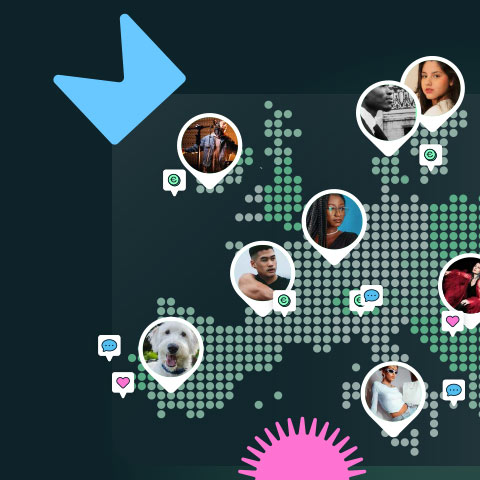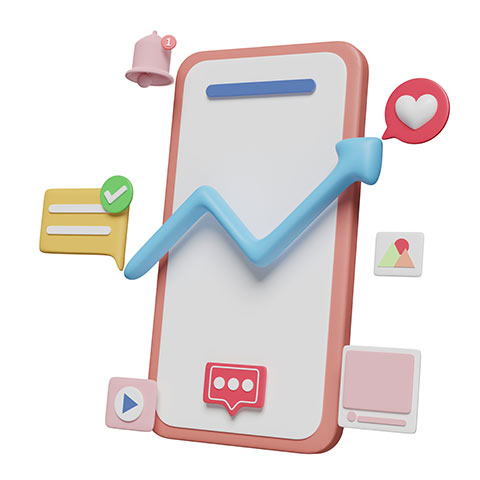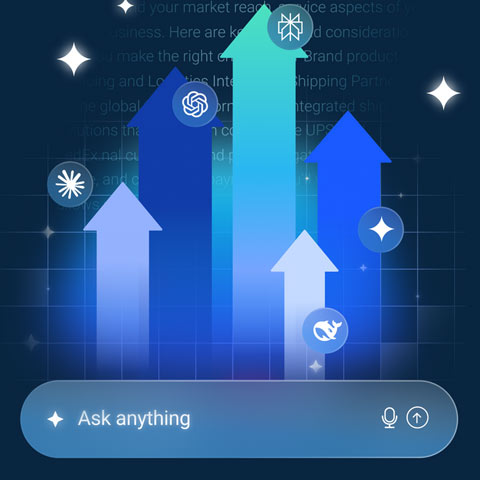How to Start Utilising Personalisation in Marketing


If you’re looking to better understand your audience and create marketing campaigns that effectively target them, personalisation in marketing is the key. Personalised marketing is more than just addressing your customers by their name in your newsletters - it’s about using analytics to reach each individual with the right message, at the right time, that appeals to their interests and values. In doing so, you can say goodbye to ineffective marketing campaigns, and ensure your marketing is unique to every customer who comes across your brand.
Here, we’ll dive into the benefits of marketing personalisation and how it's all about quality over quantity when it comes to valuable, impactful marketing.
How does personalisation fit into your strategy?
Personalisation in marketing is a data-driven technique that helps you understand your customers and ensure you target them on an individual level. Marketing personalisation can be used across several marketing channels, such as social media, email campaigns, advertising and direct mail. But how does this personalisation fit into your strategy?
With 90% of leading marketers saying personalisation significantly contributes to business profitability, it should serve as an important part of your overall marketing strategy. Each interaction your company has with a potential or existing customer is a chance to gather data that can help you target their interests and values. You can gather this customer data in various ways, such as tracking a customer’s browsing behaviour, or more overtly through customer feedback surveys. Social media is also a great way for you to gather customer data based on demographics, interests and how your audience interacts with your social media activities. This data, from shopping history to preferred social media channels, can be analysed to determine how best to target your audience and where you need to make changes to your marketing strategy.
Why is personalisation so important?
Personalisation involves you tailoring your marketing strategy or communication based on the information you have learnt about your customers. In today’s world, it’s more difficult than ever for brands to win over a customer and retain them. This is why personalisation is so important - it speaks directly to the customer, can help you stand out from your competitors and can offer a better customer experience tailored to their interests and values.
Here are just some of the key benefits of personalised marketing:
- Improved customer experience: Customers are supplying you with their data more often than you realise. Every time they browse your website, make a purchase or fill out a form, you’re receiving data such as their name, birthday or location, which you can use to offer a more personalised experience. Perhaps you can send a discount code on their birthday, which will leave them feeling appreciated for their loyalty to your brand and more likely to purchase in the future.
- Revenue: You’re likely to see an increased ROI when delivering personalised marketing. With the right marketing software, you can gain insight into which channels your customers interact with most and use this information to your advantage to deliver a personalised experience. If you can grab a customer’s attention and deliver marketing that appeals to them personally, this should provide consistent revenue growth.
- Brand loyalty: Loyal customers are undoubtedly the best kind of customers to have. They’ll tell their friends about your brand and encourage them to do business with you over your competitors. Customers who receive personalised marketing relevant to their needs and interests are more likely to continue to make purchases from you. The more they feel valued and connected, the more likely they are to stay loyal to your brand and share it with their family and friends.
Building a personalisation strategy
So, you know what marketing personalisation is and its benefits. Next, you’ll need to put together a personalisation strategy that captures your audience's attention and appeals to their interests, needs and values. Before you get started, you’ll need to implement some tools into the back end of your website which captures the data you need, such as the number of clicks your customers make, how often shopping baskets get abandoned and purchase history. Once you have this data to hand, you can begin to establish your personalisation strategy.
Here are the key steps you’ll need to take to build a successful personalisation strategy that will help you to create long-lasting relationships with your customers.
Analyse your customer base
The first step in creating a personalisation strategy is to really get to know your customers, from their demographic to buying behaviours. Once you get to know your customers, you’ll also get to know their needs and the types of marketing they’d most identify and engage with. To analyse your customer base, you’ll need to look at your customer data to understand their needs and preferences. Doing so can tell you who your customers are, their needs, the length of their decision-making process, and what content, products or campaigns they resonate with best. With these insights, you can get to grips with who is purchasing from you and what you can do to target and retain those customers with your marketing.
Build your buyer personas
The next step in creating a personalisation strategy is to start building your buyer personas. Buyer personas are semi-fictional representations of who you’re looking to market to, based on both data and research. Think of them as your ideal target audience. They’re there to help guide product development and marketing decisions to suit the needs and interests of your target customers. There are several routes you can take to build your buyer personas. You could start by diving into your customer data to identify trends in how your customers consume your content, such as which social media platform they favour. Next, ask your sales team for their opinions - what trends have they spotted? To really get to know your customers, you could interview them to find out exactly what they like and would change about your product or service.
Once you have this research, you can go on to identify patterns to develop your buyer personas. Even if you only have one primary persona to start with, this is a great resource to share with your company, so they know who they’re looking to target.
Segment your audiences
Audience segmentation is the stepping stone to marketing personalisation. Segmenting your audience into categories can help you to better understand them, and then market your product or service to them accordingly. For example, if you’re a supplier of protein shakes, you could segment your audience data based on their sport or activity preferences, their age, their income and if they have any health conditions. From there, you can better market your product by tailoring your messaging to that particular audience segment that speaks to their needs and values. By categorising your audience into groups with common interests, you can personalise your marketing campaigns to better resonate with them.
Choose the personalisation techniques you want to use
You can choose to personalise your marketing through several forms and techniques. Perhaps you’re looking to improve the email open rate of your monthly newsletter - according to Experian, emails with a personalised subject line are 26% more likely to be opened. For example, addressing your audience by name in your emails could see a spike in email open rate which could see an increase in conversions. There are many routes you could take to personalise your marketing, including:
Email marketing
Personalisation in email marketing involves you targeting an email campaign to a specific subscriber by using the data you have about them. In doing so, you’re likely to see a spike in open rate, ROI and revenue. Many people’s inboxes are cluttered with unread emails and newsletters they don’t remember subscribing to. You’ll want to be the email that stands out, that they’ll happily open and read. A great way to make this happen is to personalise the email that they receive.
There are several email personalisation methods you can make use of, including:
- “From”: Who the email is from is one of the first things your subscriber will look at when they receive your email. You can personalise the “from” name so that different subscribers see different names. For example, if your subscriber is a client that deals with you regularly, you may choose to send your marketing campaigns from their point of contact, such as your account manager, who will be a familiar face and name to them, making the email appear more personal and direct.
- Subject line: The email’s subject line tells the reader what exactly the email is about - so it’s a great marketing personalisation opportunity. You could choose to address them personally, particularly if you’re sending them a birthday discount such as ‘X, Happy Birthday! Here’s an exclusive 20% off…’ which can leave them feeling recognised and valued.
- Email copy: You can personalise the email copy itself by using your subscriber’s data, such as their first name, date of birth, or even their clothing size and recent purchase history. You can go beyond that and also personalise the imagery within your emails according to your subscriber’s gender, age or buying habits.
Personalised website content
Website personalisation involves you creating a customised experience for your visitors. Instead of each user seeing the same content, they’ll see unique content tailored to their interests or demographic. For example, you could provide targeted offers to the user based on their browsing behaviour, or display news or offers tailored to the user’s location.
Today, consumers expect a level of personalisation, due to the type of content they’re used to seeing across social media. With this in mind, many businesses are making website personalisation a priority to address this level of expectation. Here are some examples of personalised web content for you to consider:
Personalised form
An example of personalised web content is customising the forms you’re asking your customer to fill out. Web forms serve many purposes, from collecting information to surveying your customers. Personally addressing the user by their first name when they enter the web form may encourage them to complete it, as you’re establishing an immediate connection between your brand and the user.
Personalised thank you pages
If a customer has taken the time to fill out a form, make a purchase, or sign up for your newsletter, it’s only right that you thank them personally. Not only does a thank you page encourage users to take other actions on your site, such as looking at related products which can create conversion opportunities, but it also helps to maintain a personal connection with your brand. When it comes to a personalised thank you page, make sure to throw in some enthusiasm - don’t be boring! Use some emotive language like ‘Hurray! You’ve done it!’ which can make the user feel valued and appreciated.
Tracking and measuring the performance of personalisation
So, you’ve put in the work to make your customer feel special. You’re getting to know your audience through audience segmentation, you’ve personalised your website content and you’ve added a personal touch to your email campaign. But how can you track and measure the performance of marketing personalisation? Here are some key metrics to explore:
- Cart abandonment: This metric can help you to understand your customer’s purchase behaviour. Perhaps you sent them a ‘Happy Birthday!’ email but they clicked off at the checkout. This behaviour can encourage you to explore ways to avoid cart abandonment, such as sending an exclusive discount code to users who drop out at the last step. Alternatively, you may want to introduce new payment options at the checkout to make the purchase process quicker, such as Apple Pay.
- Click-through rate (CTR): Tracking the CTR of your call-to-action buttons, either on your website or emails, can help you to understand the effect of UI/UX on your customer’s decisions. Tracking the CTR of CTA buttons before and after personalisation can encourage you to make valuable changes to your UI/UX, which can affect sales.
- Average order value: If you’re looking to improve sales or cross-selling, this metric can offer valuable insight. If you’re displaying a personalised, related products section on the webpage, you can explore whether this personalisation has influenced purchase behaviour and encouraged your customer to buy more frequently, or whether their order value has increased.
See how Apteco software can help you
Watch your personalised marketing campaign pay off with the help of Apteco software. With Apteco, you can build powerful, personalised campaigns and watch prospects turn into loyal customers. You can achieve the personalisation you want across every channel with every customer.
Book a demo today to get started.
Want more like this?
Want more like this?
Insight delivered to your inbox
Keep up to date with our free email. Hand picked whitepapers and posts from our blog, as well as exclusive videos and webinar invitations keep our Users one step ahead.
By clicking 'SIGN UP', you agree to our Terms of Use and Privacy Policy


By clicking 'SIGN UP', you agree to our Terms of Use and Privacy Policy
Other content you may be interested in

Want more like this?


Want more like this?
Insight delivered to your inbox
Keep up to date with our free email. Hand picked whitepapers and posts from our blog, as well as exclusive videos and webinar invitations keep our Users one step ahead.
By clicking 'SIGN UP', you agree to our Terms of Use and Privacy Policy









